| Author |
Message |
 |
|
|
 |
|
Advert
|
Forum adverts like this one are shown to any user who is not logged in. Join us by filling out a tiny 3 field form and you will get your own, free, dakka user account which gives a good range of benefits to you:
- No adverts like this in the forums anymore.
- Times and dates in your local timezone.
- Full tracking of what you have read so you can skip to your first unread post, easily see what has changed since you last logged in, and easily see what is new at a glance.
- Email notifications for threads you want to watch closely.
- Being a part of the oldest wargaming community on the net.
If you are already a member then feel free to login now. |
|
 |
![[Post New]](/s/i/i.gif) 2017/04/27 19:50:59
Subject: theCrowe's 6mm scale WWII aircraft Gallery: German Aces High!
|
 |

Liberated Grot Land Raida
|
Forgot I had these too. The only three Russian planes in my collection so far.
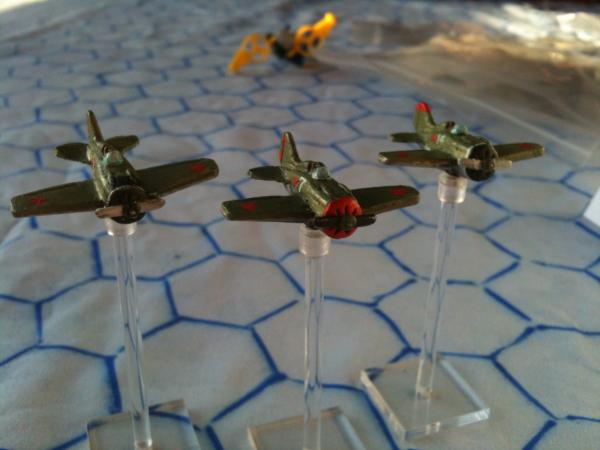
The I-16 was another relic of the Spanish Civil war that saw action in WWII. No doubt the Stukas and Bf 110's were glad of something contemporary to shoot at over Russia.
|
|
|
|
 |
 |
![[Post New]](/s/i/i.gif) 2017/04/27 20:01:06
Subject: Re:theCrowe's 6mm scale WWII aircraft Gallery: Target Objectives confirmed. Tally Ho!
|
 |

Liberated Grot Land Raida
|
And rounding things out for now I'll just add a series of my objective pieces. In all so far I've made 5 pieces. Scale-wise they're much smaller scale than the planes. The scenarios call for a 4 hex size factory or a 5 hex airfield. So really I'm just fitting the object into the size I have available.
I made all of these mostly from balsa wood except the radar towers that are made of some play clay that my kids left out. I flattened it into about a 1/4 inch thick block and cut out the pylon shapes once it had dried.
First up is the Vickers Factory at Brooklands.
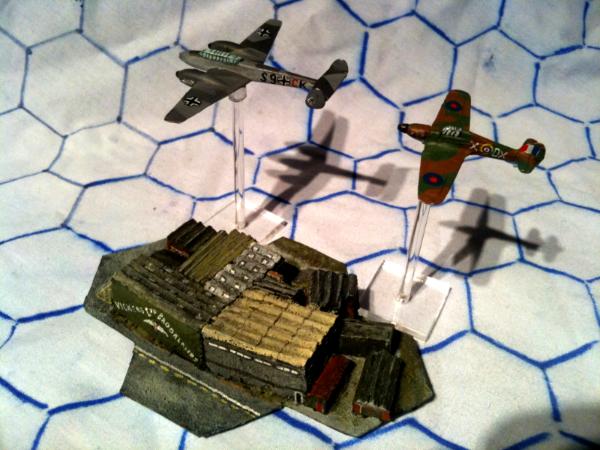
This is where Vickers built Wellington bombers.
On Sep 4th 1940 the Zerstorers of Erprgr210 made a daylight raid on the Vickers factory flying in at treetop level under the radar. 83 workers were killed and many hundreds injured in the bombing.
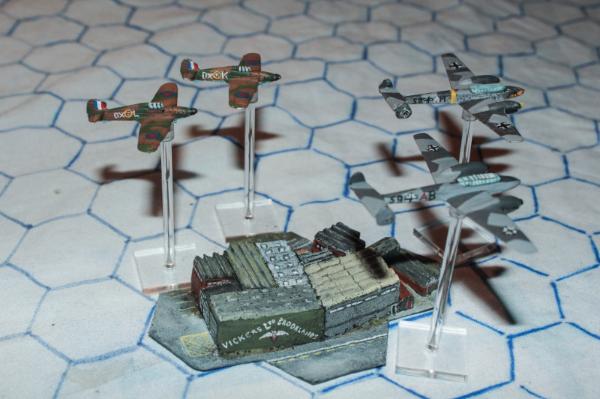
The reacting Hurricanes of 253 squadron beat a vengeful pursuit of the raiders all the way out of England.
This one is based on the radar towers of Britain's Chain home stations.
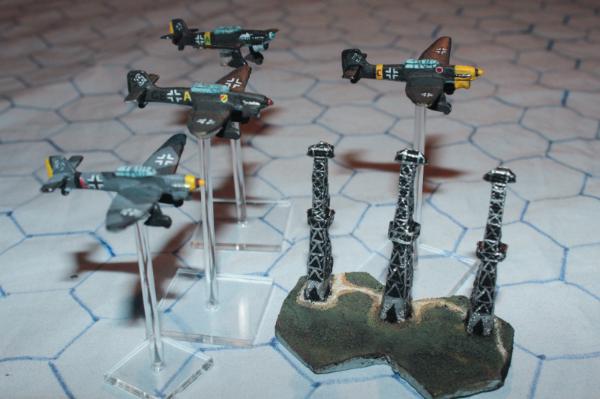
The radar defence system was a massive tactical asset giving Fighter Command a good 20 minute warning in advance of enemy raids to scramble and position its fighters.
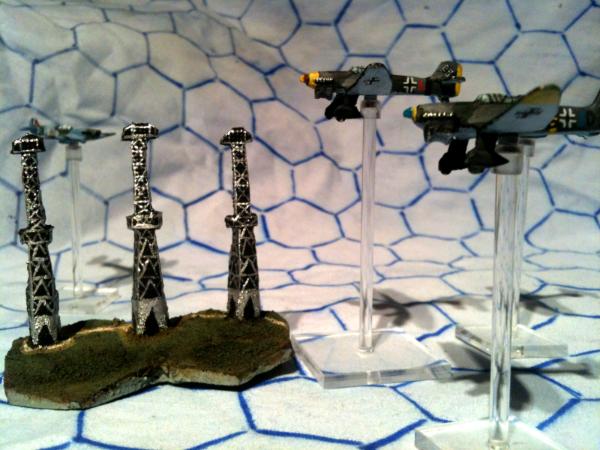
They were often the target of Luftwaffe bombing raids like on 16th August 1940 when Stukas of StG2 fell upon the Chain Home station at Ventnor, only recently restored to operational condition following an attack on the 12th. It would remain out of service following this attack for over a month.
This little bridge is (very) loosely based on the one in Vroenhoven Belgium.

One of the bridges in the mission I detailed above in the Fairey Battle's blurb; when the RAF attempted to destroy a series of Belgian bridges in an effort to slow down the German advance.
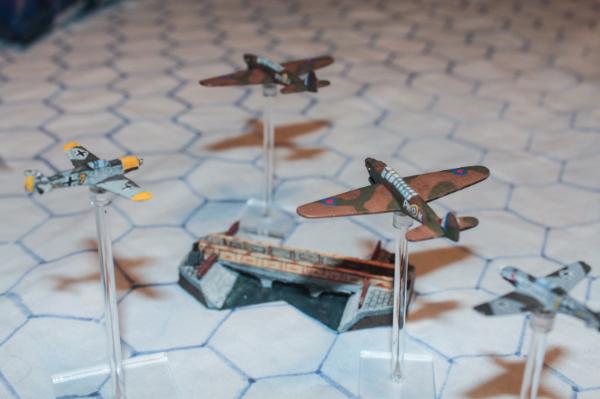
I built a little pair of German anti-aircraft guns for each side of the bridge but they mostly just throw the scale out an make it look like a much smaller bridge. Still I'm pretty happy with it.
Lastly we have a pair of airfields, complete with balsa wood command buildings, hangars, barracks huts and bunkers.
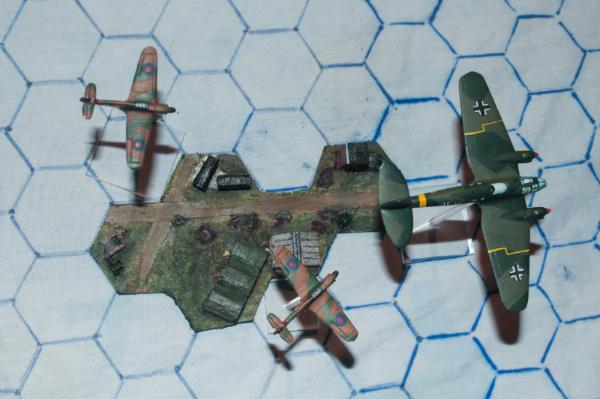
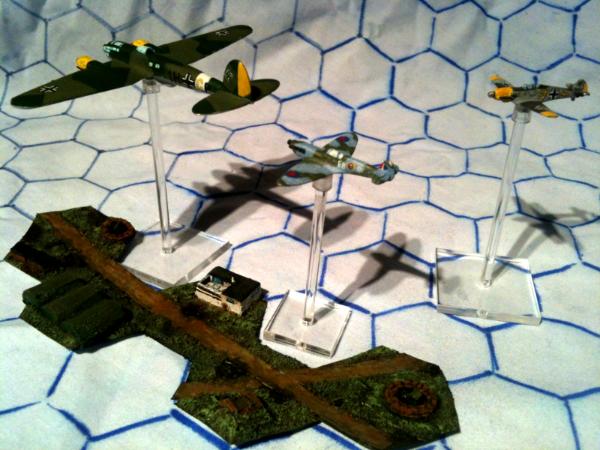
They even have a pair of light anti-aircraft guns each to defend against low level enemy bombing raids.
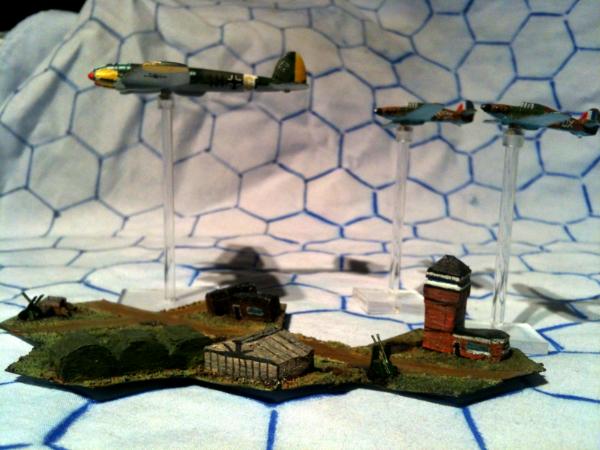
|
|
|
|
 |
 |
![[Post New]](/s/i/i.gif) 2017/04/30 18:06:21
Subject: Re:theCrowe's 6mm scale WWII aircraft Gallery: Target Objectives confirmed. Tally Ho!
|
 |

Boosting Ultramarine Biker
|
Cool Paintjob on the russian planes,thinking of buying some more now i have some paint on my hurricanes love the way they paint up,also a nice break from 40k,the cockpit is kinda fiddly but i rolled with it,Not going for Markings but might add them at a later date,they would not even exist if it was not for your sweet collection  ,of which i'am jealous.

Next on my list more hurricanes definitely a spitfire,and some 109s plus a Wulf,depending on how i do or do not pull off the dazzle like camo on the he-111&ju-88 will get more of them too,along with a couple of beaufighters,getting a bit ahead of myself though as i have no more flight bases ordered some though.
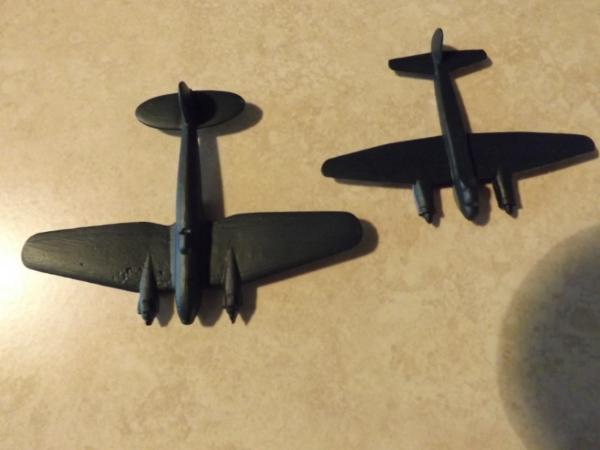
|
|
|
|
 |
 |
![[Post New]](/s/i/i.gif) 2017/04/30 21:15:44
Subject: theCrowe's 6mm scale WWII aircraft Gallery: Target Objectives confirmed. Tally Ho!
|
 |

Liberated Grot Land Raida
|
Good stuff. That's how it goes it seems, you start small and before you know it you NEEEED MOAR PLANES!
My shopping list never seems to get any shorter.
And yeah, it makes a really nice change from painting 28mm figures all the time. It's a different world.
|
|
|
|
 |
 |
![[Post New]](/s/i/i.gif) 2017/05/01 22:02:59
Subject: theCrowe's 6mm scale WWII aircraft Gallery: Target Objectives confirmed. Tally Ho!
|
 |

Troubled By Non-Compliant Worlds
|
nice paintjob - just to confirm, your models, your rules, but if you're interested, there was actually a standard camo scheme for RAF fighters, (which was reversible, called A and B schemes) so your Brit fighters should have a standardised look about them.
|
|
|
 |
 |
![[Post New]](/s/i/i.gif) 2017/05/02 19:49:18
Subject: theCrowe's 6mm scale WWII aircraft Gallery: Target Objectives confirmed. Tally Ho!
|
 |

Liberated Grot Land Raida
|
A standardised look, a little something like this.
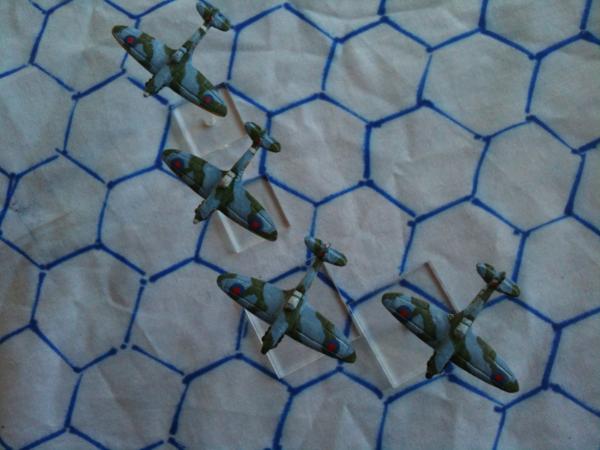
Don't sweat it man. I had my Hurricane for J. W. C. Simpson painted before I figured that one out too. You'll notice if you look at my Hurricanes his had a different camo later than the rest. Its wrong, though I've found it actually helps to identify him durring a game.
|
|
|
|
 |
 |
![[Post New]](/s/i/i.gif) 2017/05/03 19:12:37
Subject: theCrowe's 6mm scale WWII aircraft Gallery: Target Objectives confirmed. Tally Ho!
|
 |

Troubled By Non-Compliant Worlds
|
Have to say that this page caught my eye as I'm about to start something remarkably similar! :-) As part of that, I've been doing research into RAF colour schemes - would any other dakka users be interested in me posting it here, or should I keep my anorak at home? :-)
|
|
|
 |
 |
![[Post New]](/s/i/i.gif) 2017/05/03 19:44:48
Subject: theCrowe's 6mm scale WWII aircraft Gallery: Target Objectives confirmed. Tally Ho!
|
 |

Liberated Grot Land Raida
|
I would be deeply interested as I'm not done yet and wouldn't at all rule out a bunch more RAF planes in the future.
Maybe some African theatre desert colours. I know there was a yellow and black training corps scheme too, but I wouldn't be interested in painting those myself. Feel free to Post a link here when you get it put together.
|
|
This message was edited 1 time. Last update was at 2017/05/03 20:12:39
|
|
|
 |
 |
![[Post New]](/s/i/i.gif) 2017/05/04 21:21:31
Subject: Re:theCrowe's 6mm scale WWII aircraft Gallery: Target Objectives confirmed. Tally Ho!
|
 |

Troubled By Non-Compliant Worlds
|
RAF Paint Schemes in WW2: 101 :-)
Ok, so some of this might be stating the obvious, but the below is a summary of information I've gleaned from around the web to help in painting aircraft minis for a Battle of Britain game - hopefully it might be of use or interest to someone out there.
1) RAF Scheme basics. The Air Ministry was responsible for paint schemes on all RAF aircraft in WW2, in the late 30's they devised a schema where each aircraft subtype (by no. of engines, no. of crew and no. of wings) would have it's own Camouflage pattern. These schemes held through the entire war. That means that ALL single engine, single seater monoplanes, such as the 1940 Spitfires & Hurricanes, had the EXACT same pattern as the 1944 Typhoons over Normandy and the 1945 Tempests flying over Germany. The same holds true for all other types, eg the 4 engined multi crew 1941 Stirling Bomber carried the same pattern as the 1942 Lancaster. This makes painting guides fairly simple, and makes recognition of RAF fighters and bombers easy - the patterns are quite distinctive - conversely not applying the std pattern makes the aircraft look very un-RAF.
2) Variations. The original plan in 1939 was for 4 variants for each scheme. These were: A - the basic pattern, B - a mirror image of A, C - A but with the 2 tone colours reversed, and D - B but with the colours reversed. Types C & D were only ever 'provisional' and the only known usage of C is on a single Fairey Battle in the Battle of France - thus leaving types A & B.
Manufacturers were instructed to make equal numbers of airframes in type A & B, this was done by the simple expedient of turning over the rubber sheets used for masking during painting, and putting them on the opposite side of the aircraft. One consequence of this is that even and odd airframe numbers then tended to all have the same pattern type - most even serial numbered Spits had type A, while the odd numbered ones had type B - the reverse happened to be true for Hurricanes. (Note: this is a generalisation caused by manufacturing methods rather than a rule - that means that if you want to paint a specific named plane, you'll need to check if it carried type A or B camo via a picture, rather than basing it on the serial no.) From 1941, in an effort to speed production, manufacturers were instructed to just use one scheme, most picked type A, which was then used to the end of the war. (Note - the net says 'most' - I've been unable to find out if there were indeed any exceptions for planes carrying type B post 1941, but have been unable to find anything.)
3) Scheme colours. While the 'patterns' stayed the same, there were different colours for different environments (I'll cover underside variations later.)
From 1939 the main scheme was the Temperate Land Scheme : Dark Green and Dark Earth with various undersides, from mid 1940 fighters used Sky, bombers had black initially but Day bombers went to Sky.
From August 1941 as the combat took place at higher altitudes as the RAF went on the offensive, fighters adopted the Day Fighter Scheme: Dark Green and Ocean Grey with Medium Sea Grey undersides - this gave the best mix of concealment at altitude with camouflage on the concrete pens This was used until the end of the war.
Maritime types used the Temperate Sea Scheme, Dark Slate Grey and Extra Dark Sea Grey
Maritime Patrol types changed to white undersides and sides with (eventually) only Extra Dark Sea Grey tops
The Desert Scheme was Dark Earth and Mid Stone over Azure Blue
The Far East used the Temperate Land Scheme with Sky Blue undersides, later Medium Sea Grey
PR aircraft mainly used PRU Blue
4) Fighter underside variations - these changed quite often, fixing your models to a specific period.
From 1938 - June 1940 - port side black, starboard white, no roundels. This was to aid ground recognition for AA gunners as it provided a strong contrast.
From 6th June until November (ie the Battle of Britain period) the undercolour was 'Sky' to aid concealment in the air. Note though that this was a new colour and stocks were limited - thus squadrons tended to improvise with what they had to hand, either using similar colours, or mixing their own versions. This means again that if you are modelling a particular squadron in the BoB, you'll need to check what version of 'Sky' they used - the colour itself is a greeny-blue, but some squadrons used sky blue instead. Also note that as aircraft were replaced, the proper sky colours were provided on aircraft from the factories.)
In November 1940 post BoB analysis suggested that there was merit in the Black/white recognition scheme - to that end to avoid wholesale repainting just the port wings underside was painted black, the rest being left in Sky.
In April 1941 the aircraft again reverted to all under sky as the RAF took on a more offensive role, up until August, when the Temperate Scheme was replaced by the Day Fighter Scheme.
That's part 1! I'll leave part 2, roundels, nose spinners and other markings till later if this seems popular :-)
|
|
|
 |
 |
![[Post New]](/s/i/i.gif) 2017/05/05 15:52:12
Subject: theCrowe's 6mm scale WWII aircraft Gallery: Target Objectives confirmed. Tally Ho!
|
 |

Troubled By Non-Compliant Worlds
|
Hey theCrowe - knew I had another question - do you mind sharing your basing method please?
Automatically Appended Next Post:
Hey theCrowe - knew I had another question - do you mind sharing your basing method please?
|
|
This message was edited 1 time. Last update was at 2017/05/05 15:52:40
|
|
|
 |
 |
![[Post New]](/s/i/i.gif) 2017/05/05 17:06:37
Subject: theCrowe's 6mm scale WWII aircraft Gallery: Target Objectives confirmed. Tally Ho!
|
 |

Liberated Grot Land Raida
|
I picked up a few bags of Dropzone Commander flying bases and glued the little plastic cups to the top with a 2mm neo-magnet inside. Then every plane has another 2mm magnet superglued to the underside at the balance point. That way I can use whatever planes I need for a game on the same 24 bases.
Honestly the bombers would need bigger magnets, 5mm maybe. They're too big and tend to fall off the 2mm ones if you're not careful.
|
|
|
|
 |
 |
![[Post New]](/s/i/i.gif) 2017/05/05 20:58:55
Subject: theCrowe's 6mm scale WWII aircraft Gallery: Target Objectives confirmed. Tally Ho!
|
 |

Troubled By Non-Compliant Worlds
|
ok, thanks. I've picked up Bag the Hun, so will start with fighters but will need/want to expand to HE111s and Ju88s so there's stuff to escort etc, probably no need for any 4 engined beasts.
|
|
|
 |
 |
![[Post New]](/s/i/i.gif) 2017/05/07 22:10:39
Subject: theCrowe's 6mm scale WWII aircraft Gallery: Target Objectives confirmed. Tally Ho!
|
 |

Liberated Grot Land Raida
|
By the way, I also enjoyed your RAF paint scheme summary and look forward to reading more on the undersides. That's where the real complicated action is at. Most of my RAF don't have underside roundels. Cobbler Kain's hurricane does, and has the black/white half and half scheme. And the Beaufighter has underside roundels because its based on a coastal command unit from May 1941 (I think, can't recall exactly) there's a photo of that exact plane that I based it on and it has them.
Most of my bomber command planes have all black undersides.
There's actually a surprising amount of variation overall considering how strictly regulated the RAF were with their paint schemes. I gave m Spitfires a range of variations mostly so I could tell them apart in game, after experiencing the frustration of trying to keep track of four almost identical Hurricanes on the tabletop at once.
My Germans are a little easier to keep track of.
|
|
|
|
 |
 |
![[Post New]](/s/i/i.gif) 2017/05/14 21:42:14
Subject: Re:theCrowe's 6mm scale WWII aircraft Gallery: Target Objectives confirmed. Tally Ho!
|
 |

Liberated Grot Land Raida
|
Just a few underside shots to help illustrate the various Underside schemes. These are by no means exhaustive, authoritative or for sure, its mostly been my best guess and instinct, and on occasion the paints available to hand at the time.
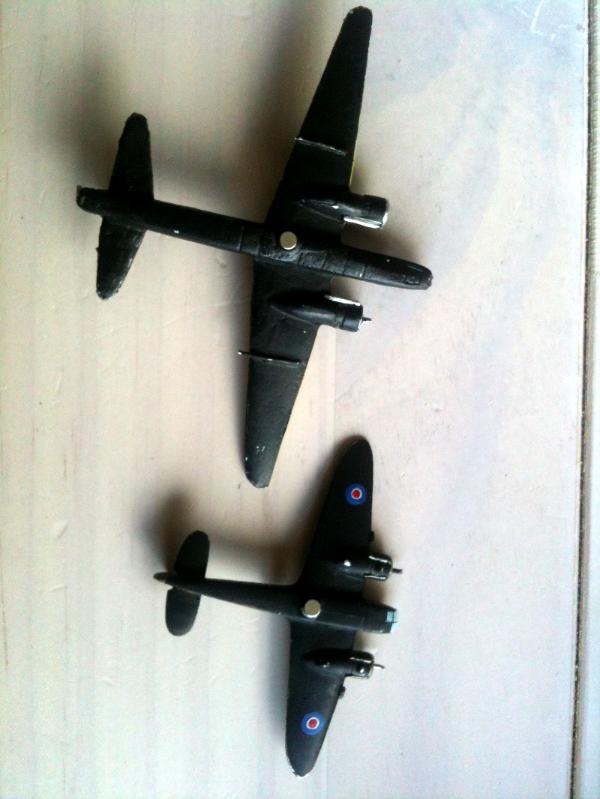
Bomber command planes had all black undersides with Roundels removed to make them harder to spot at night. Roundels were added later on to aid identification by friendly anti-aircraft gunners.
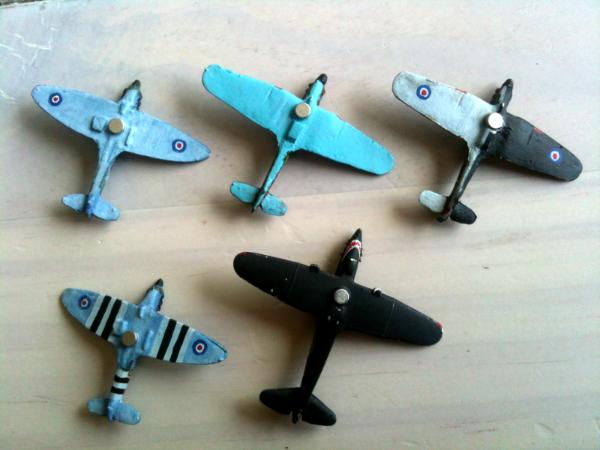
The various fighter command underside schemes includes the black/white half and half scheme from early on. Then the variously duck-egg-ish blue without roundels. Followed by the return of the underside roundels and also with invasion stripes. And lastly a night fighter in all black.

I've given my fleet air arm fulmars a pale grey/white underside with roundels and my Coastal command Beaufighter has a darker grey underside (though it maybe should've been duck-egg) and underside roundels placing it at the end of 1940 (when 252 squadron got Beaufighters and before the order would have been sent to have the underside roundels painted over)
And just by way of example here's a German He 111 and FW 190D. The Luftwaffe had various markers in yellow on the go with engine cowling being the most common and others including wing tips and fuselage bands in various theatres. German Crosses were standard underside markings occasionally with aircraft code lettering beside.

Other variants of underside German crosses have only the four right angle corners in black. Like this FW 190D I think this was done only later in the war.
|
|
|
|
 |
 |
![[Post New]](/s/i/i.gif) 2017/05/29 22:40:24
Subject: theCrowe's 6mm scale WWII aircraft Gallery: Target Objectives confirmed. Tally Ho!
|
 |

Troubled By Non-Compliant Worlds
|
Great stuff - reminds me I need to write up on roundels - difficulty is that there are so many exceptions it's hard to find the rule! :-)
|
|
|
 |
 |
![[Post New]](/s/i/i.gif) 2017/05/29 22:47:23
Subject: theCrowe's 6mm scale WWII aircraft Gallery: Target Objectives confirmed. Tally Ho!
|
 |

Longtime Dakkanaut
Looking for the Rest of the II Legion
|
Nicely done!
|
|
|
|
 |
 |
![[Post New]](/s/i/i.gif) 2017/10/11 22:41:26
Subject: Re:theCrowe's 6mm scale WWII aircraft Gallery: YOU ESSS EH! YOU ESSS EH!
|
 |

Liberated Grot Land Raida
|
Finally got around to bringing the USA into the war. (Think that's an actual quote from FDR)
I'll kick this one off with a couple of early paint scheme aircraft from the United States Navy.
these are both in the early 1942 scheme with the red disc in the center of the National Aircraft Insignia and horizontal red and white rudder striping.
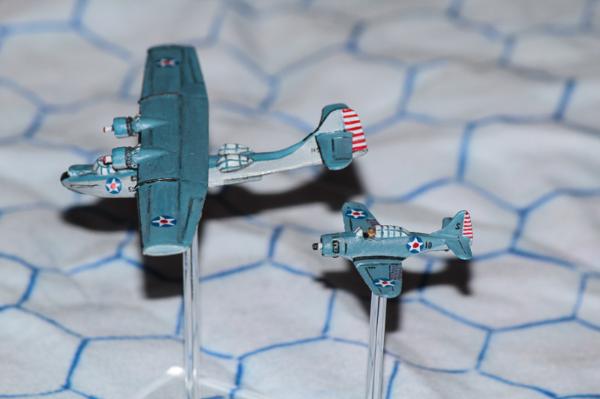
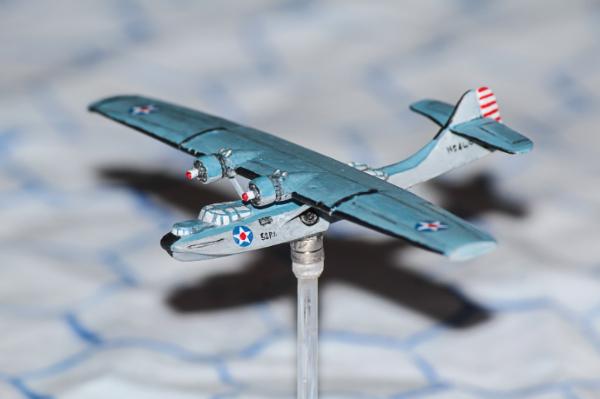
the absolutely beautiful Consolidated PBY Catalina flying boat. These were the most versatile and widely used flying boat of the war and continued to see service long after in some armed forces as late on as the 1980s!!! Some modern day fire fighting services still use them as water bombers!
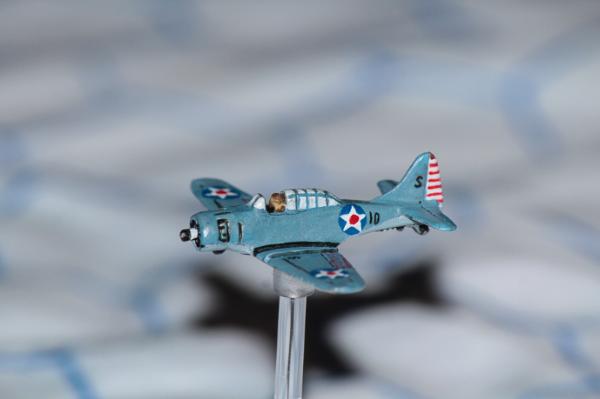
This is the Douglas SBD Dauntless of pilot Stanley "Swede" Vejtasa who once, when attacked by three A6M2 Zero fighters shot two of them down and cut off the wing of the third in a head-on pass with his wingtip. Proper aviation badassery that. I'll be painting up three zeros soon just for that game.
More 'Mercan planes to come soon.
|
|
This message was edited 1 time. Last update was at 2017/10/11 22:46:01
|
|
|
 |
 |
![[Post New]](/s/i/i.gif) 2017/10/12 00:02:06
Subject: theCrowe's 6mm scale WWII aircraft Gallery: YOU ESSS AY! YOU ESSS AY!
|
 |

Fixture of Dakka
CL VI Store in at the Cyber Center of Excellence
|
Again, just gorgeous. Fantastic work.
|
Every time a terrorist dies a Paratrooper gets his wings. |
|
|
 |
 |
![[Post New]](/s/i/i.gif) 2017/10/13 18:39:46
Subject: theCrowe's 6mm scale WWII aircraft Gallery: YOU ESSS AY! YOU ESSS AY!
|
 |

Liberated Grot Land Raida
|
Thanks very much CptJake.
I'm on a real aircraft kick these days so I'm turning them out quicker than an oversubscribed wartime production line, and I'm really enjoying it again too.
Next up its a few more painted planes, that is planes based on ones that were painted in American factories. The USAAF started using this kind of olive drab for a while before the factories just stopped painting them altogether.
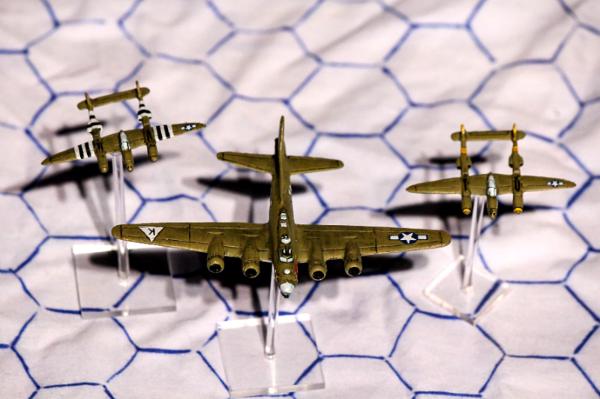
These are the mean greens.
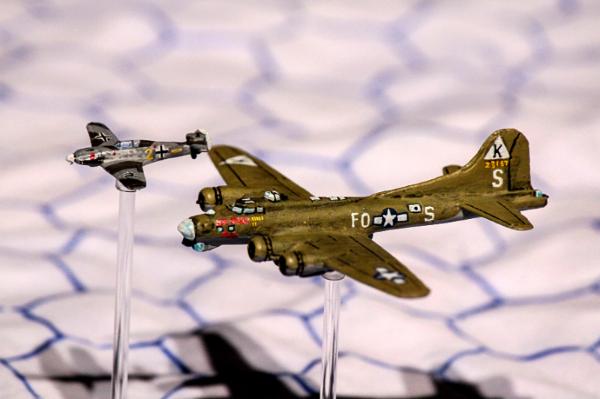
This is of course "Ye Olde Pub" the B-17 of USAAF pilot Charlie Brown (yes really) whose plane got shot to absolute shreds on a bombing run over Bremen. A Luftwaffe fighter, Franz Stigler took off to investigate and found it to be the most damaged plane he'd ever seen still flying. He chose not to attack the B-17 but attempted to convince Brown to land and save his wounded crew. Brown did not wish to be captured in Germany or make for nearby neutral Sweden and kept flying for England. Stigler escorted the B-17 to the coast before returning home. Both pilots met 40 years later and were friends until Stigler's death in 2008.
You can read lots more on The Charlie Brown and Franz Stigler incident here.
Next up its one of my absolute all time favourite planes the Lockheed P-38 Lightning aka "the fork-tailed devil"
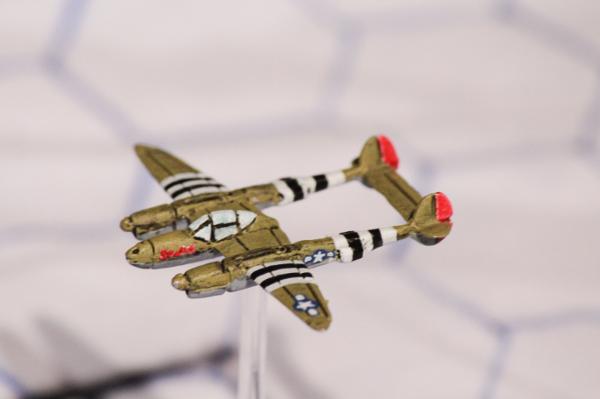
This is "Scat II" the P-38 flown by a young Captain Robin Olds. In the 479th fighter group over occupied France in preparation for the invasion of Normandy. Olds went on to fly P-51 Mustangs over Germany finishing his wartime service with a plethora of medals and awards. His long and distinguished airforce career continued until his retirement in 1973 as Brigadier General.
|
|
This message was edited 1 time. Last update was at 2017/10/13 18:50:14
|
|
|
 |
 |
![[Post New]](/s/i/i.gif) 2017/10/14 12:27:43
Subject: Re:theCrowe's 6mm scale WWII aircraft Gallery: YOU ESSS AY! YOU ESSS AY!
|
 |

Boosting Ultramarine Biker
|
Them are some cleanly painted lines on them planes,damn nice colors also,guessing that's not GW paint your using,The Catalina looks lush as does the b17 them kill marking are well small.
America definitely designed some pretty looking planes in ww2,cool to see you are still painting can be difficult to stay motivated. Nice work on the Lightnings too,a beast of a plane them things.
|
|
|
|
 |
 |
![[Post New]](/s/i/i.gif) 2017/10/15 19:53:31
Subject: theCrowe's 6mm scale WWII aircraft Gallery: YOU ESSS AY! YOU ESSS AY!
|
 |

Liberated Grot Land Raida
|
Thanks man. Glad to be back at it.
Sticking with the P-38 for now (because look at these things!) but this time I've done a couple in bare metal silver schemes.
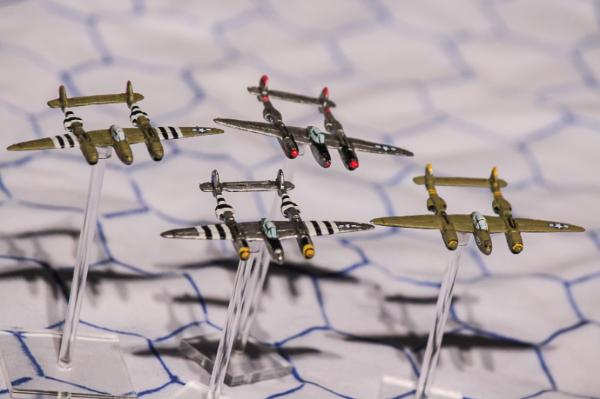
No more famous flyers (that I know of) this time. Just a couple of examples of the kind of style I was seeing. Note the black anti-glare panels painted in front of the cockpits and on the sides of the engines facing the pilot. These were often done in black or the standard USAAF green.
This sleek looking light bomber is a Douglas A-26 Invader.
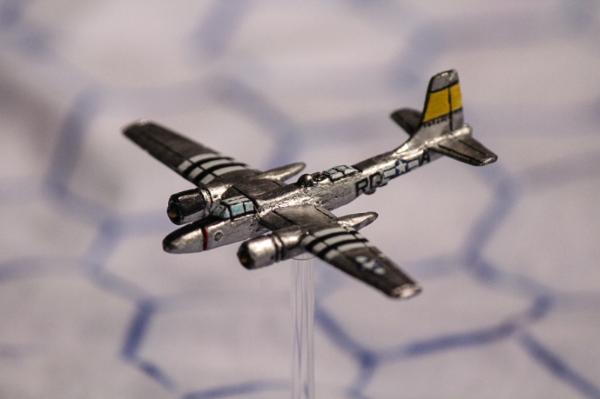
Another shiny silver scheme with invasion stripes. (It is an 'Invader' afterall) Though their deployment was delayed due to terrible visibility from the cockpit needing to be rectified, so they didn't see service in Europe until September 44 missing the D-day invasion by a few months. Still there's every likelihood a new Allied plane in Sep 44 would've warranted identification stripes until they were all done away with by the end of the year.
These machines were fast and lethal ground attack and low level bombing aircraft and packed an absolute metric butt-load of weaponry compared to anything else of their type. They remained in service after WW2 on through the Korean War and into Vietnam finally retiring in 1969.
And while we're on the topic of Invasion Stripes.
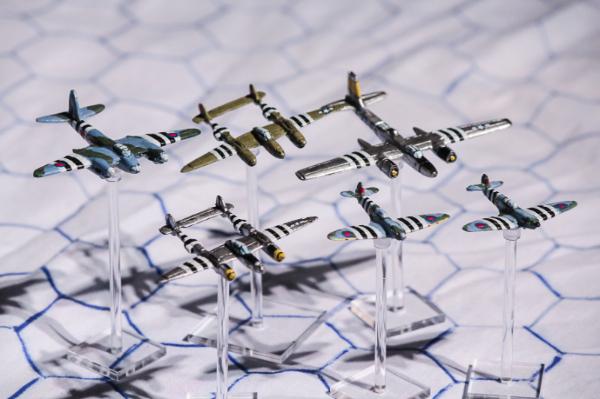
These are all my invasion striped aircraft so far. Given the wide variety of paint schemes from the various allied airforces involved in the invasion of Normandy you can see the need for this kind of identification marking.
So that wraps up my collection of American aircraft for now. (Got more in the post so look out for them in the future.) Here's all my American planes together.

Now salute the flag and repeat after me, You ess ay!
|
|
This message was edited 1 time. Last update was at 2017/10/15 19:56:28
|
|
|
 |
 |
![[Post New]](/s/i/i.gif) 2017/10/23 20:49:19
Subject: Re:theCrowe's 6mm scale WWII aircraft Gallery: Bombs away, Jolly good show chaps, lets go home.
|
 |

Liberated Grot Land Raida
|
Ok folks, before you read any further you're going to have to open this link in a new tab for some appropriate atmosphere music.
Done? Then on with the post.
That's right if you haven't guessed already its the mighty four engined symbol of British wartime Britishness. Its the all time champion of dam-busting, tall-boy toting, blockbusting, grand slamming and general purpose aerial bombardment, the mighty Avro Lancaster.
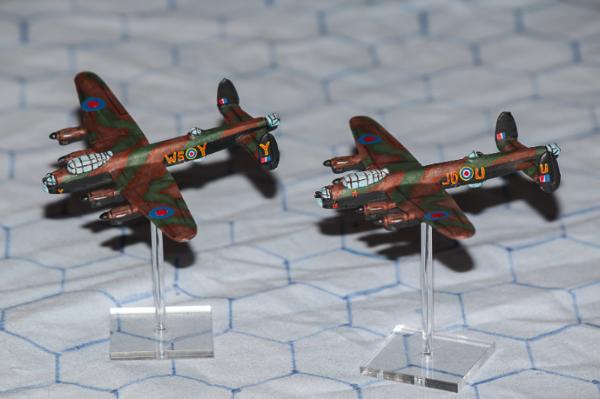
Probably the most recognised heavy bomber in the history of ever. A testament to its seemingly endless versatility and adaptability. It's large unobstructed loading bay could accommodate the demands of ever increasing sizes of bombs (unlike the Short Stirling) and it was said to have been a remarkably fast and nimble aircraft for its weight.
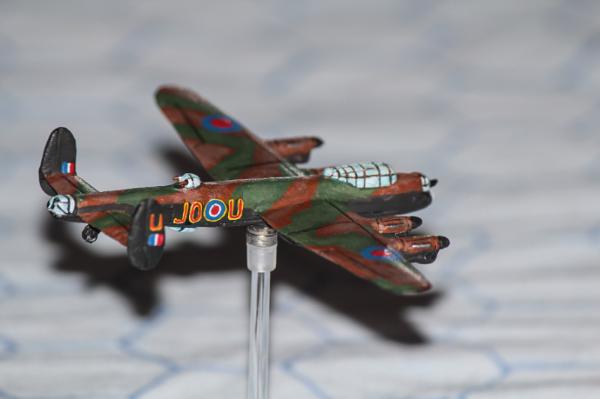

And just for the spectacle of it here's all my RAF bombers in a big group shot.
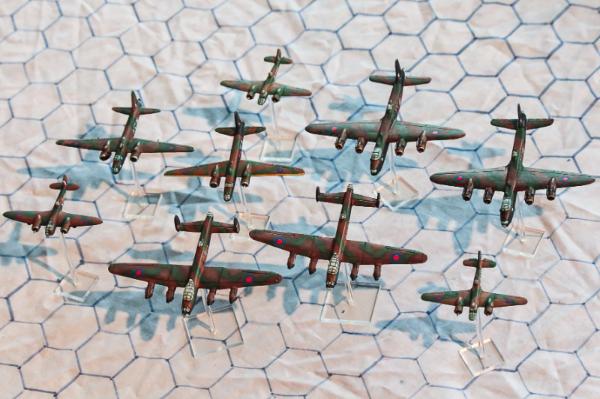
Thanks for looking folks. More to come soon I hope.
|
|
This message was edited 1 time. Last update was at 2017/10/23 20:54:18
|
|
|
 |
 |
![[Post New]](/s/i/i.gif) 2017/10/23 21:05:51
Subject: theCrowe's 6mm scale WWII aircraft Gallery: Bombs away, Jolly good show chaps, lets go home.
|
 |

Joined the Military for Authentic Experience
On an Express Elevator to Hell!!
|
Absolutely brilliant stuff, quite excellent level of detail you have achieved at the scale.
A highlight for me is the Catalina, definitely think the paint job does justice to such a beautiful aircraft.
|
|
|
|
 |
 |
![[Post New]](/s/i/i.gif) 2017/10/24 05:34:41
Subject: theCrowe's 6mm scale WWII aircraft Gallery: Bombs away, Jolly good show chaps, lets go home.
|
 |

Second Story Man
|
I love your "twin-tailed devils". Very good work!
|
Are you a Wolf, a Sheep, or a Hound?
Megavolt wrote:They called me crazy…they called me insane…THEY CALLED ME LOONEY!! and boy, were they right.
|
|
|
 |
 |
![[Post New]](/s/i/i.gif) 2017/11/02 20:26:08
Subject: theCrowe's 6mm scale WWII aircraft Gallery: Macchi style!
|
 |

Liberated Grot Land Raida
|
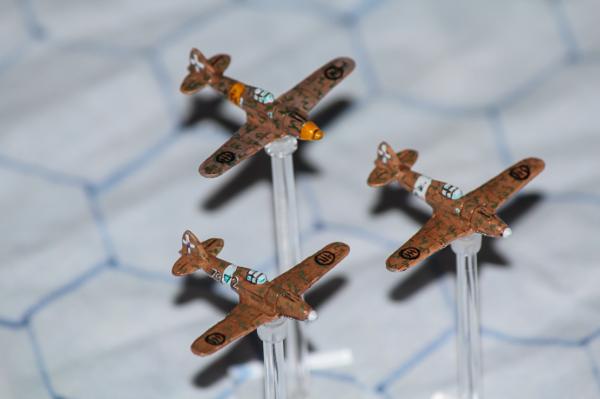
The Macchi C.202 Folgore (Italian "thunderbolt")
These fast machines look sleek and deadly. A real piece of Italian style in the air. Unfortunately for the Regia Aeronautica that was about as far as it went.
A woefully insufficient compliment of only two nose-mounted machine guns (that were quite prone to jamming) combined with faulty radios and inefficient oxygen systems meant that their pilots rarely had the resources to push these elegant fliers to success.
But still, they were the best fighters the Italians had and were best not underestemated.
I've just had a big batch of planes delivered so expect more here soon. Some more mostly Americans and some Japanese so watch this space for more tiny ( although that B-29 is a monster!) aircraft hopefully sooner than later.
Thanks everyone for viewing these and most especially for all your kind comments and encouragement. It keeps me enthusiastic to keep on researching collecting and painting.
|
|
This message was edited 1 time. Last update was at 2017/11/03 17:52:09
|
|
|
 |
 |
![[Post New]](/s/i/i.gif) 2017/11/25 21:15:21
Subject: Re:theCrowe's 6mm scale WW2 aircraft Gallery: Tora! Tora! Tora!
|
 |

Liberated Grot Land Raida
|
I'll drop in a few Japanese aircraft quickly before getting back into my USAAF collection.
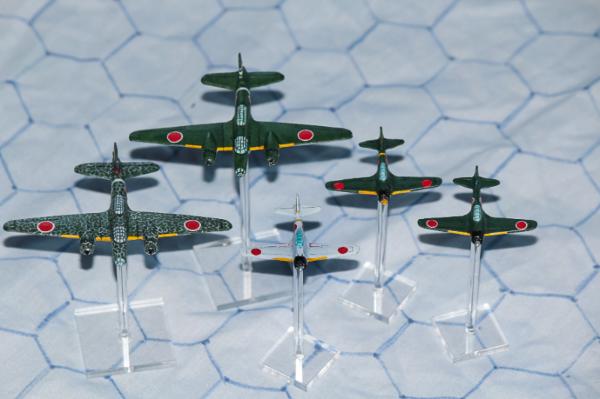
First up its the absolute icon that is the Mitsubishi A6M "Zero" 
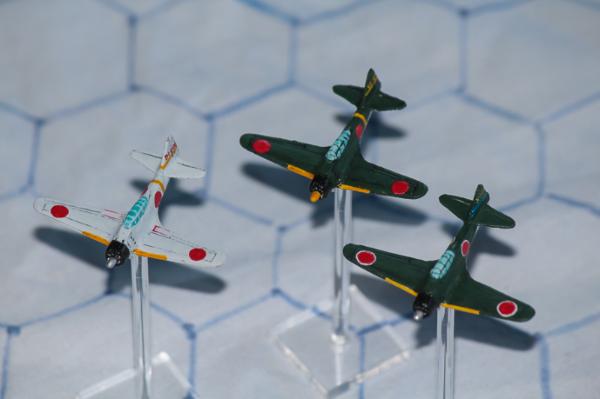
When these bad boys appeared in the skies of the Pacific Theatre they were faster and more manoeuvrable than any of their USAAF adversaries. Speed was very much their armour though as their light weight airframe couldn't take much punishment.
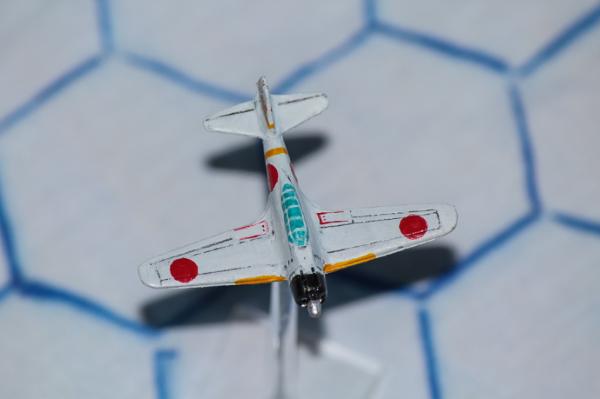
This is the Zero of Petty Officer Tadayoshi Koga whose final mission ended in a crash landing on the North Pacific Alaskan island of Akutan. In July 1942 the plane was found mostly intact and was the first flyable Zero the United States had gotten a hold of. It was considered a prize beyond value in the fight to defeat the Imperial Japanese forces and was quickly tested and evaluated by the USAAF. They learned a lot about its capabilities and limitations but mostly confirmed what many of their pilots in the pacific were already learning the hard way.
Next up its the venerable Mitsubishi Ki-21 "Sally".
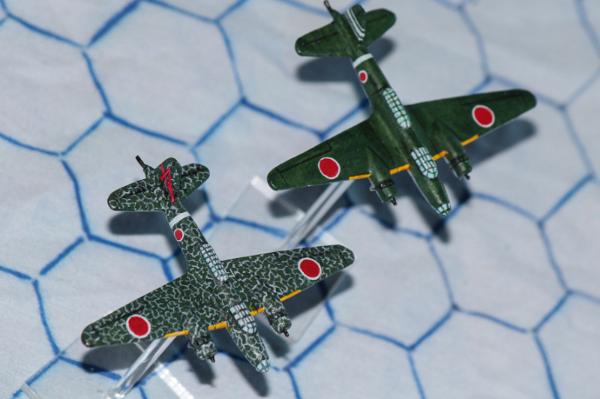
These were first deployed in 1938 flying bombing missions over China proving their worth as reliable long range medium bombers.
They underwent numerous upgrades including a remote controlled 'stinger' tail gun, larger loading bays and engines and control surfaces however by 1942 they were becoming increasingly obsolete.
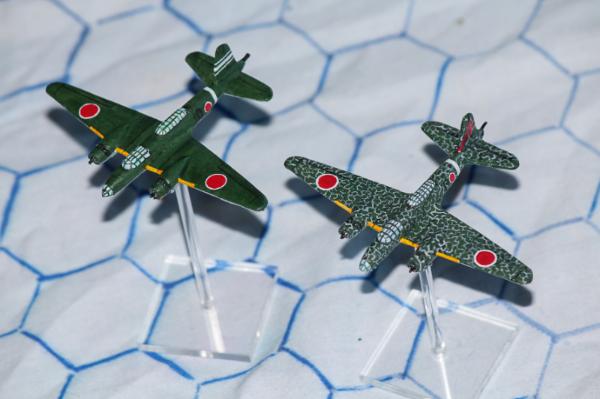
Originally designated the code name 'Jane' it was changed to "Sally" due to General MacArthur's objections, Jean being the name of his wife.
|
|
This message was edited 1 time. Last update was at 2017/11/27 18:58:27
|
|
|
 |
 |
![[Post New]](/s/i/i.gif) 2017/11/27 18:36:55
Subject: Re:theCrowe's 6mm scale WW2 aircraft Gallery: Tora! Tora! Tora!
|
 |

Liberated Grot Land Raida
|
Back with the USAAF again and I've taken it back to both sides of 1942 with a pair of Brewster Buffalos.
The attack on Pearl Harbour gave the Top Brass of the USAAF a lot of thinking to do, and among the many changes to be made was a new paint scheme. Gone were the yellow wings of the 1930s and in January 1942 the National Insignia roundels were added to both upper and lower wing positions.
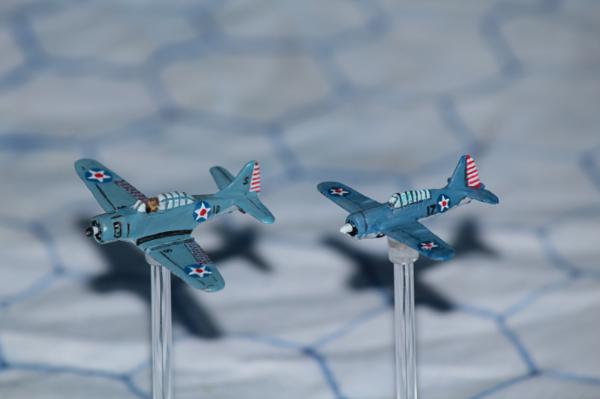
This picture shows both a Brewster F2A Buffalo and a larger Douglas Dauntless in early 1942 colours.
Then in May 1942 the roundel was revised to remove the red portion to better distinguish it from the Japanese Hinomaru, and the tail stripes were dropped too leaving just the plain blue and white insignia in six positions. Buffalos that flew in the Battle of Midway would have been painted like this.

The Brewster F2A Buffalo was over-weight underpowered and unstable and the Japanese fighters it was up against could fly rings around it. By 1942 the much derided "Flying Coffin" was largely considered an obsolete 2nd line aircraft better suited to training duties than front line fighting. That said the Finnish Air Force made a great success of their Buffalo squadrons producing 36 Buffalo Aces.
I've also done an earlier model B-17 in an early 1942 scheme.
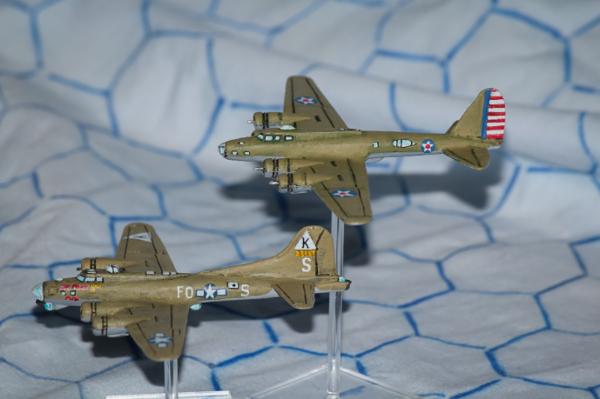
The B-17 D and E were two distinctly different aircraft. Following front line deployment by both the RAF and USAAF the new B-17E got a redesigned tail with a larger vertical stabiliser, a dorsal gun turret, a tail gunner position and the ventral 'bathtub' gunner's position was replaced with a bubble turret.
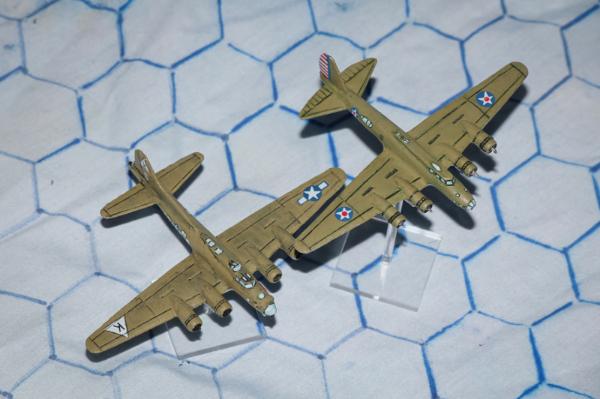
|
|
|
|
 |
 |
![[Post New]](/s/i/i.gif) 2017/12/02 12:39:20
Subject: Re:theCrowe's 6mm scale WW2 aircraft Gallery: Thunder, Thunder, Thunderbolts! Ho!
|
 |

Liberated Grot Land Raida
|
Yes folks, the mighty Republic P-47 Thunderbolt fighter bomber. These are some older Razorback models introduced in November 1942.
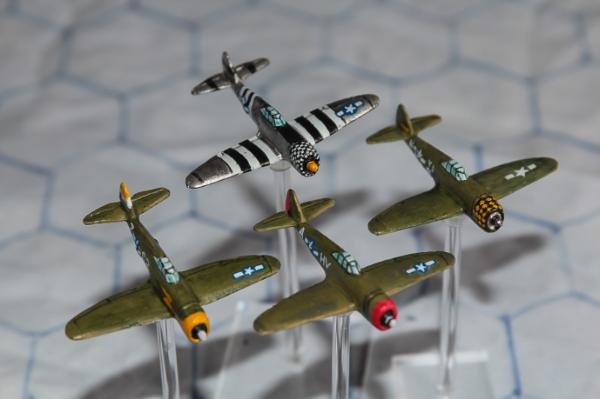
The mighty "Jug" (Juggernaut) was among the heaviest single engine fighters of the war. It was a big bruiser of a fighter that could give as as good as it got and it became the real workhorse of the USAAF.
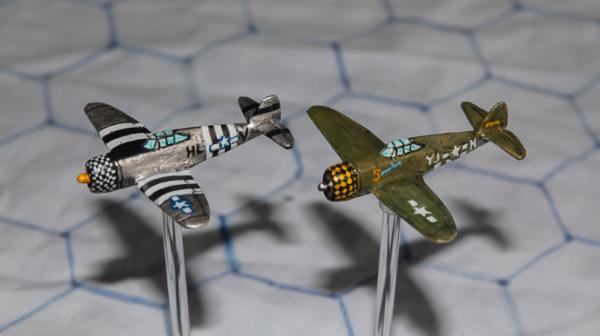
They weren't good climbers but man could they dive. German fighter pilots soon learned that you couldn't dive out of a fight with a Thunderbolt like you could from a Spitfire but they had no trouble climbing up and over them. A new propellor helped solve that problem.
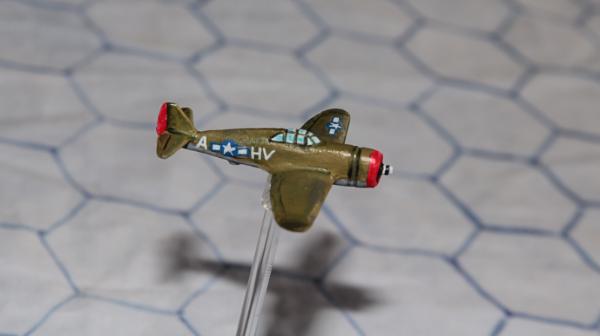
This Thunderbolt was one flown by Francis Stanley "Gabby" Gabreski, the highest scoring Thunderbolt Ace of the war. Gabreski flew 166 combat sorties and was officially credited by the USAAF with 28 aircraft destroyed in air combat and 3 on the ground. He was captured in July 1944 and remained a POW in Germany until he was liberated by Soviet forces in April 1945. He would go on to become a Korean War jet ace and eventually retired from service in the USAF as a Colonel in November 1967.
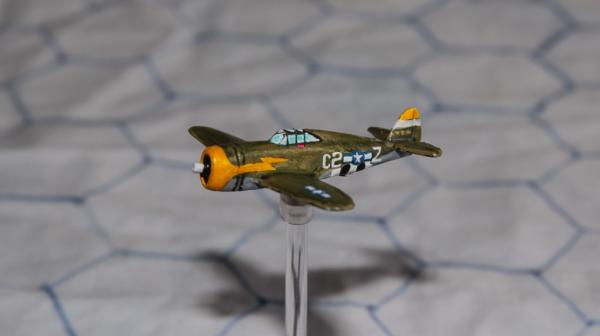
This is "Margie II" flown by Gerald Grace who Flew 96 missions with the 396th Fighter Group. Once shot down by ground flak near Soissons, France, Aug. 31,1944 in German held territory, he evaded capture and managed to make his return to base exactly 24 hours after being shot down, setting a new record for passing through Paris. His plane was named after Marjorie, his sweetheart back home, whom he married in 1945. They had nine kids together.
|
|
This message was edited 1 time. Last update was at 2017/12/02 12:58:19
|
|
|
 |
 |
![[Post New]](/s/i/i.gif) 2017/12/02 13:14:01
Subject: theCrowe's 6mm scale WW2 aircraft Gallery: Thunder, Thunder, Thunderbolts! Ho!
|
 |

Rampaging Reaver Titan Princeps
|
Cool stuff here one of the advantages of working near Duxford sometimes is seeing their historic aircraft in the sky.
|
"But me no buts! Our comrades get hurt. Our friends die. Falkenburg is a knight who swore an oath to serve the church and to defend the weak. He'd be the first to tell you to stop puling and start planning. Because what we are doing-at risk to ourselves-is what we have sworn to do. The West relies on us. It is a risk we take with pride. It is an oath we honour. Even when some soft southern burgher mutters about us, we know the reason he sleeps soft and comfortable, why his wife is able to complain about the price of cabbages as her most serious problem and why his children dare to throw dung and yell "Knot" when we pass. It's because we are what we are. For all our faults we stand for law and light.
Von Gherens This Rough Magic Lackey, Flint & Freer
Mekagorkalicious -Monkeytroll
2017 Model Count-71
|
|
|
 |
 |
![[Post New]](/s/i/i.gif) 2017/12/02 17:05:56
Subject: Re:theCrowe's 6mm scale WW2 aircraft Gallery: Thunder, Thunder, Thunderbolts! Ho!
|
 |

Boosting Ultramarine Biker
|
Inspirational work as always,the level of detail you manage to pull off on the tiny planes is very nice,compare to my skills at painting the planes your skills far outpace my skills at it,gives me something to aspire to though. 
|
|
|
|
 |
 |
|
|